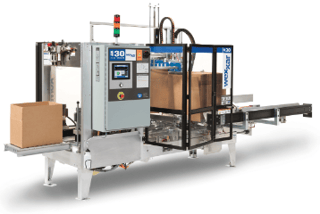 For many companies, the search for ways to control costs and improve margins is never-ending. From the start of the production process to the end, manufacturers in many different industries are struggling to save time, labor, and capital while maintaining strict product quality standards.
For many companies, the search for ways to control costs and improve margins is never-ending. From the start of the production process to the end, manufacturers in many different industries are struggling to save time, labor, and capital while maintaining strict product quality standards.
The last leg of the production process, where goods/products are packaged for delivery to the distribution channel, is especially important to companies that seek to move their products to global markets. Here, end of line automation can help companies save in several ways.
End of Line Automation and Labor Savings
Manually packing shipping containers and crates is a slow, time-consuming and labor-intensive process. The faster your production line runs, the more people need to be there at the end of the line to make sure that products are packed as quickly as they are made.
Using automated systems for packing products into regular slotted cases (RSCs) can help to reduce the amount of labor needed to pack products for delivery. Even light semi-automatic automation can greatly increase the efficiency of the end of line packing process, allowing your workers to pack more shipping crates with less overall labor.
How significant is the labor savings? In many cases, a light semi-automatic automation solution can pay for itself in as little as six months. More heavily automated and complicated packing solutions, while more expensive, also further reduce the reliance on manual labor and provide even faster packing.
End of Line Automation and Savings from Production Throughput Improvements
It doesn’t matter if your production process can send 30 units per minute down the line if the packers can only box 10 units per minute. When production speed outpaces your workers’ ability to pack them for shipment, the whole process is slowed down to the speed at which the end of line packers can move.
Making sure that your end of line packaging process can keep up with your production speed helps to improve your throughput, allowing you to fill more orders per day and keep up with demand. This is crucial for keeping buyers satisfied and relying on you for stock.
Consider the above example. If your shipping output is limited to 10 units a minute because of slow manual packing methods, then changing over to an automation solution that can match the 30 units per minute rate of your production facility would triple output without adding labor costs. If you could previously fill two trucks a day with product, this would increase your shipping output to six trucks a day.
Better yet, faster packing at the end of the line means that you can make more efficient use of your production facility, as you don’t have to scale production back on account of a slow packing process.
End of Line Automation and Savings from Worker Safety
At the end of the production process, manual labor used for packing materials and goods, particularly heavy ones, carries with it a risk of worker injuries. Worker injuries can be a concern for many reasons, including:
- Investigations by OSHA (or an equivalent organization outside of the U.S.). Major safety incidents frequently serve as the catalyst for formal investigations. The results of said investigation may lead to stringent, expensive new measures being required of your company to prevent future incidents.
- Time lost on production. During a safety incident, production grinds to a halt as workers shut down production and scramble to save their co-worker from further harm.
- Loss of a worker. If an injury is severe enough, it may completely remove that employee from the work force for weeks or months. Hiring a replacement and training him or her to take over can take time. Until that worker comes back or a replacement has been brought up to speed, your production can be slowed down significantly from what it was.
- Potential lawsuits for unsafe work environment. During any safety incident, there will always be the question of employer responsibility. Even when all due precautions for manually loading and moving packages are made, an accident can potentially result in a long and costly legal battle over your responsibility for the injury as an employer.
By automating the end of line packing process, you remove workers from harm’s way as heavy packages are being prepared. This helps to improve safety and reduce the number of time-lost safety incidents your factory has.
Learn more about end of line automation on our End of Line Automation page, or contact Plan Automation directly for more information.




